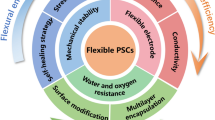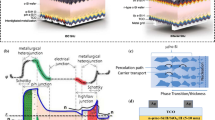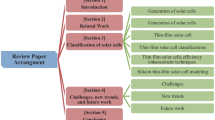Abstract
The main objective of this paper is to present the fabrication of a flexible double-heterojunction gallium arsenide solar cell and analyse the photoelectric characteristics by experimental and numerical investigations. Remote epitaxy was used in addition to metal–organic chemical vapour deposition (MOCVD) to fabricate the flexible GaAs thin film. The practical power conversion efficiency (PCE) of the fabricated double heterojunction was nearly 20%, as tested by a solar simulator at air mass global condition AM1.5G (1000 W/m2 insolation and 25 °C). The photoelectric characteristics, including the generation and recombination rates, band bending, carrier concentration and electric potential, were numerically investigated by COMSOL Multiphysics/Semiconductor Module. The experimental PCE was compared with the photovoltaic (PV) cell simulation data of 29% PCE using the MATLAB code/Newton–Raphson method. The comparison was not satisfactory, since the practical solar cell was exposed to high series resistance, which affected the PCE of the thin-film solar cell.









Similar content being viewed by others
Data availability
The data will be shared on reasonable request.
References
Al-Ezzi, A.: The market of solar panels in the United Kingdom. Appl. Solar Energy (English translation of Geliotekhnika) (2017). https://doi.org/10.3103/S0003701X17010029
Chee, A.K.W.: On current technology for light absorber materials used in highly efficient industrial solar cells (2023)
Belich, N.A., Petrov, A.A., Ivlev, P.A., Udalova, N.N., Pustovalova, A.A., Goodilin, E.A., Tarasov, A.B.: How to stabilize standard perovskite solar cells to withstand operating conditions under an ambient environment for more than 1000 hours using simple and universal encapsulation. J. Energy Chem. 78, 246–252 (2023). https://doi.org/10.1016/j.jechem.2022.12.010
Al-Ezzi, A., Abass, A.: Selecting the most suitable material for punch dies using CES EduPack. In: ISMSIT 2018 - 2nd International Symposium on Multidisciplinary Studies and Innovative Technologies, Proceedings. Institute of Electrical and Electronics Engineers Inc. (2018)
Al-Ezzi, A., Al-Bawee, A., Dawood, F., Shehab, A.A.: Effect of bismuth addition on physical properties of Sn-Zn lead-free solder alloy. J. Electron. Mater. 48, 8089–8095 (2019). https://doi.org/10.1007/s11664-019-07577-w
Li, C., Poplawsky, J., Yan, Y., Pennycook, S.J.: Understanding individual defects in CdTe thin-film solar cells via STEM: From atomic structure to electrical activity (2017)
Loulou, M., Turkestan, M.K.A., Brahmi, N., Abdelkrim, M.: Current dependence of series and shunt resistances of solar cells. In: 2018 9th International Renewable Energy Congress, IREC 2018. pp. 1–5. Institute of Electrical and Electronics Engineers Inc. (2018)
Das, R., Ray, S.: Transparent conducting zinc oxide as anti-reflection coating deposited by radio frequency magnetron sputtering. Indian J. Phys. 86, 23 (2012). https://doi.org/10.1007/s12648-012-0010-9
Sahoo, D., Manik, N.B.: Study on the effect of temperature on electrical and photovoltaic parameters of lead-free tin-based Perovskite solar cell. Indian J. Phys. 97, 447–455 (2023). https://doi.org/10.1007/s12648-022-02401-4
Cotfas, D.T., Cotfas, P.A., Machidon, O.M.: Study of temperature coefficients for parameters of photovoltaic cells. Int. J. Photoenergy (2018). https://doi.org/10.1155/2018/5945602
Movla, H., Babazadeh, M., Sadreddini, S.V.: Influence of α particle radiation on the structural and electronic properties of thin film GaAs solar cells: a simulation study. Optik 127, 3844–3847 (2016). https://doi.org/10.1016/j.ijleo.2016.01.063
Al-Ezzi, A.S., Ansari, M.N.M.: Photovoltaic solar cells: a review (2022)
Cordero, R.R., Damiani, A., Laroze, D., MacDonell, S., Jorquera, J., Sepúlveda, E., Feron, S., Llanillo, P., Labbe, F., Carrasco, J., Ferrer, J., Torres, G.: Effects of soiling on photovoltaic (PV) modules in the Atacama Desert. Sci. Rep. (2018). https://doi.org/10.1038/s41598-018-32291-8
Maghami, M.R., Hizam, H., Gomes, C., Radzi, M.A., Rezadad, M.I., Hajighorbani, S.: Power loss due to soiling on solar panel: a review. Renew. Sustain. Energy Rev. 59, 1307–1316 (2016). https://doi.org/10.1016/j.rser.2016.01.044
Papež, N., Škvarenina, Ľ., Tofel, P., Sobola, D.: Thermal stability of gallium arsenide solar cells. In: International Society for Optics and Photonics. p. 1060313. International Society for Optics and Photonics, Prague, Czech Republic (2017)
Jalled, O., Siblini, A., Chatelon, J.P.: New technique to measure low-frequency permeability of thin magnetic films surrounded by a current sheet in a multilayer environment. Indian J. Phys. 87, 751–755 (2013). https://doi.org/10.1007/S12648-013-0298-0/METRICS
Rouway, M., Boulahia, Z., Chakhchaoui, N., Fouzia, F., el Hachemi Omari, L., Cherkaoui, O., van Langenhove, L.: Mathematical and numerical modelling of soiling effects of photovoltaic solar panels on their electrical performance. In: IOP Conference Series: Materials Science and Engineering. Institute of Physics Publishing (2020)
Teyou Ngoupo, A., Ouédraogo, S., Ndjaka, J.M.: Numerical analysis of interface properties effects in CdTe/CdS: O thin film solar cell by SCAPS-1D. Indian J. Phys. 93, 869–881 (2019). https://doi.org/10.1007/s12648-018-01360-z
Ali, Z.H., Ahmed, A.K., Saeed, A.T.: Modeling solar modules performance under temperature and solar radiation of Western Iraq. Int. J. Power Electron. Drive Syst. 9, 1842–1850 (2018). https://doi.org/10.11591/ijpeds.v9.i4.pp1842-1850
Reis, L.R.D., Camacho, J.R., Novacki, D.F.: The newton raphson method in the extraction of parameters of PV modules. Renew. Energy Power Qual. J. 1, 634–639 (2017). https://doi.org/10.24084/repqj15.416
Abu Md, M., Islam, S., Tanvirul, M.: Modeling of single diode solar photovoltaic module using Matlab. Int. J. Comput. Appl. 178, 39–45 (2017). https://doi.org/10.5120/ijca2017915772
Al-Ezzi, A.S., Ansari, M.N.M., Ahmed, S.K., Tan, N.M.L., Nordin, N.A., Nomanbhay, S.M.: Analytical modelling, simulation and comparative study of multi-junction (GaInP2/InGaAs/Ge) solar cell efficiency. J. Comput. Electron. (2023). https://doi.org/10.1007/s10825-023-02021-z
Shishkin, I.A., Lizunkova, D.A., Latukhina, N.V.: Simulation of current-voltage characteristics and power-voltage characteristics of “space” solar cells based porous silicon in the Comsol Multiphysics package. In: Journal of Physics: Conference Series. Institute of Physics Publishing (2019)
Gruginskie, N., van Laar, S.C.W., Bauhuis, G., Mulder, P., van Eerden, M., Vlieg, E., Schermer, J.J.: Increased performance of thin-film GaAs solar cells by rear contact/mirror patterning. Thin Solid Films 660, 10–18 (2018). https://doi.org/10.1016/j.tsf.2018.05.042
Acknowledgements
The authors would like to thank Tenaga Nasional Berhad, Malaysia, for their support through Seeding Fund Research Grant Code: U-TV-RD-20-10 and UNITEN R&D Sdn. Bhd. Malaysia. The authors would like to thank Jeehwan Kim and Hyunseok Kim at the Massachusetts Institute of Technology, USA, for providing test samples for measurements.
Author information
Authors and Affiliations
Contributions
Conceptualization, A.S.A.-E., M.N.M.A.; writing—original draft preparation, A.S.A.-E.; writing—review and editing, A.S.A.-E., M.N.M.A.; resources and funding acquisition, M.N.M.A. All authors have read and agreed to the published version of the manuscript.
Corresponding author
Ethics declarations
Competing interests
The authors declare that they have no competing interests.
Ethics approval and consent to participate
Not applicable.
Consent for publication
Not applicable.
Additional information
Publisher's Note
Springer Nature remains neutral with regard to jurisdictional claims in published maps and institutional affiliations.
Rights and permissions
Springer Nature or its licensor (e.g. a society or other partner) holds exclusive rights to this article under a publishing agreement with the author(s) or other rightsholder(s); author self-archiving of the accepted manuscript version of this article is solely governed by the terms of such publishing agreement and applicable law.
About this article
Cite this article
Al-Ezzi, A.S., Ansari, M.N.M. Numerical analysis and performance study of a double-heterojunction GaAs-based solar cell. J Comput Electron (2024). https://doi.org/10.1007/s10825-023-02126-5
Received:
Accepted:
Published:
DOI: https://doi.org/10.1007/s10825-023-02126-5




